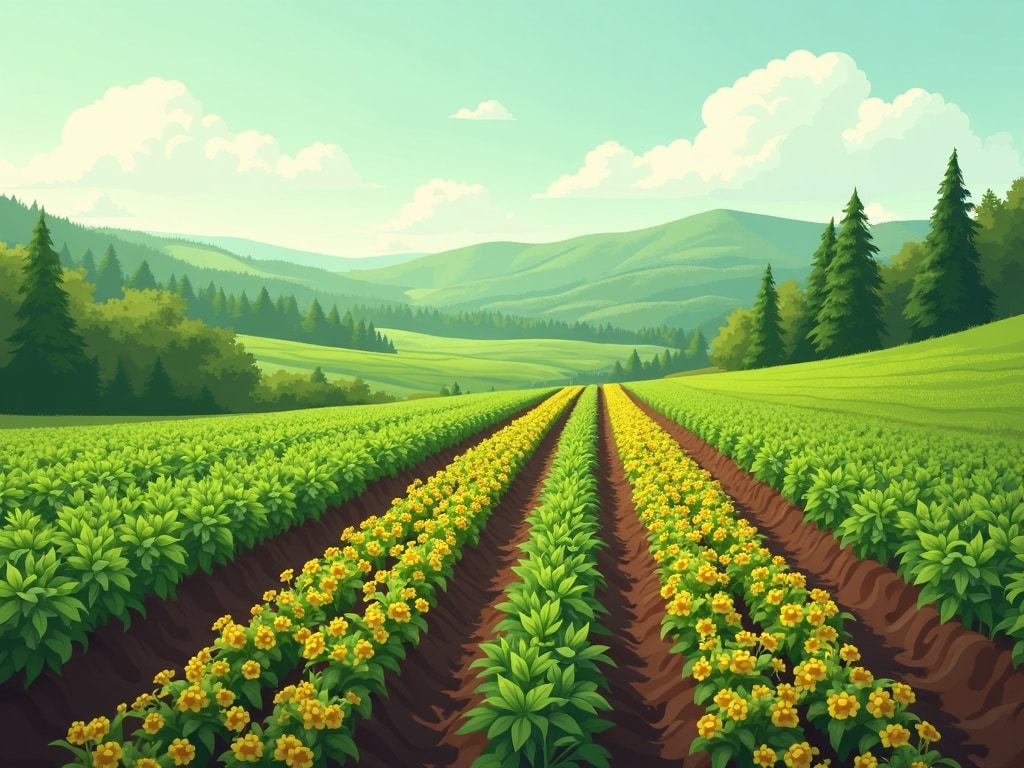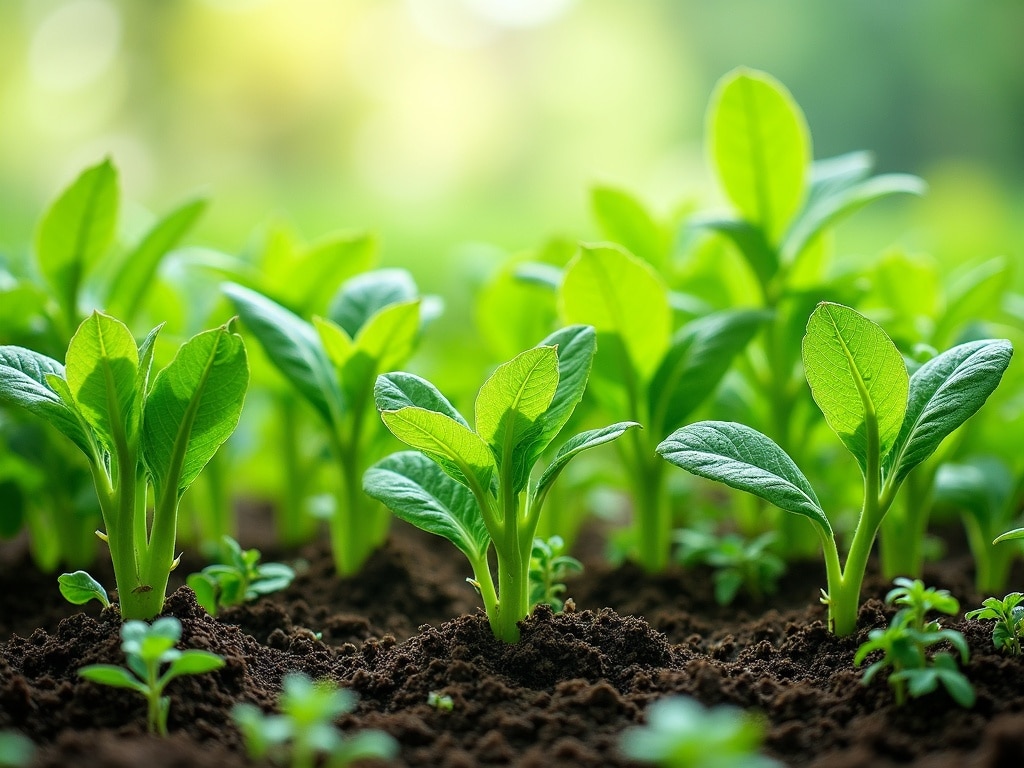Green Manure Crop Rotation: The Ultimate Guide to Soil Health and Sustainable Farming
Imagine a field brimming with lush, vibrant growth, not of a cash crop destined for market, but of a powerful soil-enhancing cover crop. This isn't just picturesque; it's the heart of green manure crop rotation, a cornerstone of sustainable agriculture. For generations, farmers have understood the profound benefits of strategically incorporating specific plants into their rotation to boost soil fertility, suppress weeds, and improve overall land health. It's a natural, regenerative approach that's more relevant than ever in today’s world of depleted soils and increasing environmental awareness.
What is Green Manure Crop Rotation?
Green manure crop rotation is the practice of growing specific plants, known as green manures, not for harvest, but to be incorporated back into the soil. These plants are typically grown for a specific period, then tilled or mowed and left to decompose, enriching the soil with organic matter and nutrients. Think of it as a strategic investment in the long-term health and productivity of your farmland. It's a foundational element of organic farming, and increasingly adopted by conventional farmers looking for sustainable methods to improve their soil.
The Key Difference: Green Manure vs. Cover Crops
While the terms are often used interchangeably, there's a subtle but important distinction. Both green manures and cover crops are planted to benefit the soil, but their primary purpose differs. Cover crops are grown primarily to protect the soil from erosion, suppress weeds, and improve water infiltration. Green manures, on the other hand, are specifically grown to be incorporated into the soil to add nutrients and organic matter. Often, a single plant can serve as both a cover crop and a green manure. The key lies in how it's managed. If it's tilled in, it's functioning as a green manure. If it's left on the surface or used as mulch, it's primarily a cover crop.
The Benefits of Green Manure Crop Rotation
The advantages of incorporating green manure crop rotation into your farming practices are numerous and far-reaching. From improved soil health to reduced reliance on synthetic fertilizers, here's a closer look at the key benefits:
**Improved Soil Fertility:Green manures add significant amounts of organic matter to the soil. This organic matter acts like a sponge, improving water retention, aeration, and drainage. It also provides food for beneficial soil organisms, leading to a healthier soil ecosystem.
**Nutrient Enhancement:Leguminous green manures, such as clover, alfalfa, and peas, have the remarkable ability to fix nitrogen from the atmosphere. This process, carried out by symbiotic bacteria in their root nodules, converts atmospheric nitrogen into a form that plants can use. When the green manure is incorporated into the soil, this nitrogen is released, providing a natural source of fertilizer for subsequent crops.
**Weed Suppression:A dense stand of green manure can effectively smother weed growth, reducing the need for herbicides. The competitive nature of these plants prevents weeds from establishing themselves, leading to cleaner fields and healthier crops.
**Erosion Control:Green manures act as a protective blanket for the soil, preventing erosion caused by wind and rain. Their roots bind the soil particles together, reducing runoff and preserving valuable topsoil.
**Improved Soil Structure:The roots of green manure plants help to break up compacted soil, improving aeration and drainage. This creates a more favorable environment for plant growth.
**Pest and Disease Management:Certain green manures can suppress soilborne pests and diseases. For example, some varieties of mustard release compounds that are toxic to nematodes, tiny worms that can damage plant roots.
**Reduced Reliance on Synthetic Fertilizers:By providing a natural source of nutrients, green manures can significantly reduce the need for synthetic fertilizers. This not only saves money but also reduces the environmental impact of farming.
Choosing the Right Green Manure
Selecting the appropriate green manure for your specific needs and location is crucial for maximizing its benefits. Consider these factors when making your choice:
**Climate and Soil Conditions:Different green manures thrive in different climates and soil types. Choose plants that are well-suited to your local conditions. For example, winter rye is a cold-hardy option for temperate climates, while cowpeas are a heat-tolerant choice for warmer regions.
**Desired Benefits:Determine what you want to achieve with your green manure. Are you primarily looking to add nitrogen to the soil, suppress weeds, or improve soil structure? Different green manures offer different benefits. Legumes are ideal for nitrogen fixation, while grasses are excellent for weed suppression and erosion control.
**Crop Rotation:Consider the needs of your subsequent crops. Choose a green manure that will provide the right nutrients and soil conditions for the crops you plan to grow next.
**Growth Rate:Some green manures grow quickly, while others take longer to establish. Choose a plant that will fit into your cropping schedule.
**Cost and Availability:Consider the cost of seed and the availability of different green manure options in your area.
Here's a breakdown of some popular green manure options:
**Legumes:**
**Clover (Red, White, Crimson):Excellent nitrogen fixers, improve soil structure, and suppress weeds.
**Alfalfa:Deep-rooted legume, improves soil drainage, and adds significant amounts of nitrogen.
**Peas (Field Peas):Fast-growing legume, well-suited for cool-season planting.
**Beans (Fava Beans, Cowpeas):Effective nitrogen fixers, tolerant of various soil conditions.
**Vetch (Hairy Vetch):Winter-hardy legume, provides excellent nitrogen fixation and weed suppression.
**Grasses:**
**Rye (Winter Rye):Cold-hardy, suppresses weeds, and prevents erosion.
**Oats:Fast-growing, improves soil structure, and suppresses nematodes.
**Barley:Similar to oats, but more tolerant of alkaline soils.
**Brassicas:**
**Mustard (White Mustard, Brown Mustard):Suppresses nematodes and other soilborne pests, adds organic matter to the soil.
**Radish (Daikon Radish):Deep-rooted, breaks up compacted soil, and improves drainage.
Integrating Green Manure into Your Crop Rotation
Incorporating green manure into your crop rotation requires careful planning and timing. Here's a step-by-step guide:
1. **Plan Your Rotation:Determine where the green manure will fit into your overall crop rotation. Consider the needs of your cash crops and the benefits that different green manures can provide.
2. **Prepare the Soil:Prepare the soil as you would for any other crop. This may involve tilling, fertilizing, or amending the soil.
3. **Sow the Green Manure:Sow the green manure seeds at the recommended rate and depth. Consult seed packets or your local agricultural extension office for specific recommendations.
4. **Manage the Growth:Monitor the growth of the green manure and manage any potential problems, such as weeds or pests.
5. **Incorporate the Green Manure:The timing of incorporation is crucial. Ideally, you want to incorporate the green manure when it's at its peak biomass production but before it sets seed. This maximizes the amount of organic matter and nutrients added to the soil.
6. **Prepare for the Next Crop:After incorporating the green manure, allow it to decompose for a few weeks before planting your next crop. This will give the nutrients time to become available to the plants.
7. **Methods of Incorporation:**
**Tillage:Using a plow, tiller, or disc to turn the green manure into the soil. This is the most common method, but can be disruptive to soil structure.
**Mowing and Covering:Mowing the green manure and then covering it with a tarp or mulch to promote decomposition. This method is less disruptive to soil structure than tillage.
**No-Till:Using a no-till planter to plant the next crop directly into the green manure residue. This method minimizes soil disturbance and preserves soil structure.
Specific Green Manure Crop Rotation Strategies
Here are some specific examples of how you might integrate green manure crop rotation into different farming systems:
Discover Proven Techniques to Preserve Your Food Year-Round and Enjoy Less Waste with More Freshness
**Vegetable Gardens:**
**Fall/Winter:Plant winter rye or hairy vetch after harvesting summer vegetables. Incorporate in the spring before planting warm-season crops.
**Summer:Plant cowpeas or buckwheat in areas that will be fallow for part of the summer. Incorporate before planting fall vegetables.
**Orchards:**
**Between Rows:Plant clover or alfalfa between rows of trees. This will help to improve soil fertility and suppress weeds. Mow regularly to prevent the green manure from competing with the trees.
**Field Crops (Corn, Soybeans, Wheat):**
**Before Corn:Plant a leguminous green manure, such as hairy vetch or crimson clover, in the fall after harvesting the previous crop. Incorporate in the spring before planting corn.
**After Wheat:Plant buckwheat or mustard after harvesting wheat. Incorporate before planting a fall cover crop or leaving the field fallow.
Challenges and Considerations
While green manure crop rotation offers numerous benefits, there are also some challenges to consider:
**Cost of Seed:The cost of green manure seed can be a barrier for some farmers, especially those with large acreage.
**Time Commitment:Growing and incorporating green manures requires time and effort.
**Potential for Pest and Disease Problems:Some green manures can harbor pests or diseases that could affect subsequent crops.
**Weed Management:While green manures can suppress weeds, they can also become weeds themselves if not managed properly.
**Incorporation Timing:The timing of incorporation is crucial for maximizing the benefits of green manure. Incorporating too early or too late can reduce its effectiveness.
The Future of Green Manure Crop Rotation
As the world faces increasing challenges related to soil degradation, climate change, and food security, green manure crop rotation is poised to play an increasingly important role in sustainable agriculture. Research is ongoing to identify new and improved green manure varieties, develop more efficient methods of incorporation, and better understand the complex interactions between green manures, soil, and crops.
With growing consumer demand for sustainably produced food, farmers who adopt green manure crop rotation practices are not only improving the health of their land but also gaining a competitive edge in the marketplace. It’s a holistic approach to farming that benefits the environment, the farmer, and the consumer.
The journey to healthier soil is not a sprint, but a marathon. Green manure crop rotation is a powerful tool in that journey, offering a sustainable path to richer soils, healthier crops, and a more resilient agricultural system. Embracing this age-old practice is an investment in the future of our farms and the well-being of our planet.


